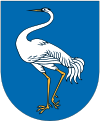Visaginas
| Visaginas | |||
|---|---|---|---|
| Municipality | |||
|
|||
 |
|||
| Location of Visaginas | |||
| Coordinates: 55°35′53″N 26°26′17″E / 55.598°N 26.438°ECoordinates: 55°35′53″N 26°26′17″E / 55.598°N 26.438°E | |||
| Country |
|
||
| Ethnographic region | Aukštaitija | ||
| County |
|
||
| Municipality | Visaginas municipality | ||
| Capital of | Visaginas municipality | ||
| Established | 1975 | ||
| Granted city rights | 1995 | ||
| Area | |||
| • Total | 58 km2 (22 sq mi) | ||
| Population (2016-01-20) | |||
| • Total | 19,776 | ||
| Time zone | EET (UTC+2) | ||
| • Summer (DST) | EEST (UTC+3) | ||
| Website | http://www.visaginas.lt/ | ||
Visaginas (![]() pronunciation ) is the centre of Lithuania's youngest municipality, located on the north-eastern edge of the country. It was built as a town for workers engaged in the construction of the Ignalina Nuclear Power Plant. Russian is the first language of the vast majority of town population. Originally the aerial view of Visaginas was designed to resemble a butterfly, however, after work on the nuclear power plant was cancelled, so was further construction of the town. Currently Visaginas consists of three residential regions that locals refer to as the 1st, 2nd and 3rd Microdistricts. Visaginas have 14 streets. The city grew up in a pine forest by Lake Visaginas. Tourism is currently an area of great potential, as is the possibility of a new nuclear power plant.
pronunciation ) is the centre of Lithuania's youngest municipality, located on the north-eastern edge of the country. It was built as a town for workers engaged in the construction of the Ignalina Nuclear Power Plant. Russian is the first language of the vast majority of town population. Originally the aerial view of Visaginas was designed to resemble a butterfly, however, after work on the nuclear power plant was cancelled, so was further construction of the town. Currently Visaginas consists of three residential regions that locals refer to as the 1st, 2nd and 3rd Microdistricts. Visaginas have 14 streets. The city grew up in a pine forest by Lake Visaginas. Tourism is currently an area of great potential, as is the possibility of a new nuclear power plant.
The administrative centre of the Visaginas municipality is situated near the country's biggest lake, Drūkšiai. Its administrative boundaries are in the process of being defined. The Vilnius–Daugavpils railway runs alongside the town, providing convenient communication with those cities. Motorways connect the town with all other cities in the republic.
In the distant past, the surroundings of Visaginas were inhabited by the Selonians. Historical annals first mention the location in 1526, when it was presented by the nobleman Vaitiekus Goštautas to the Naujasis (New) Daugėliškis parish. In the 14th–19th centuries the region was invaded by the Livonian, Swedish, Russian and French troops.
...
Wikipedia



